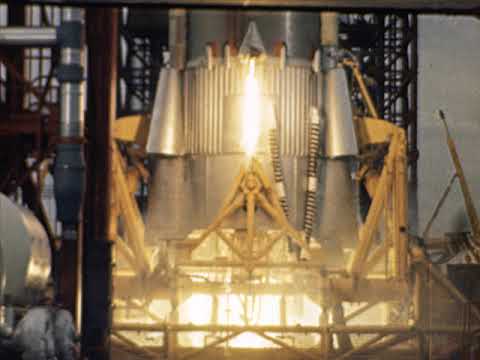The Centaur upper stage was the world’s first rocket to fly using liquid hydrogen and oxygen as propellants. Its development began in 1958 as a joint venture between the U.S. Air Force, ARPA, and Convair, manufacturer of the Atlas missile. Convair designed the Centaur using the same stainless steel pressure-stabilised “balloon tank” structure as the Atlas booster with power supplied by two RL10 engines, whose expander cycle provided a very high specific impulse of 425 seconds, later uprated to as high as 453.8 seconds in later versions of the Centaur.
Convair developed a special version of the Atlas booster to launch the Centaur, with stretched fuel tanks, structural reinforcement to carry the heavy upper stage, and more powerful booster engines. The development process was protracted and trouble-prone, with the first Atlas-Centaur sitting on the launch pad for seven months before being launched on 1962-05-08. Less than a minute after liftoff, the rocket disintegrated into a huge fireball, which was captured by numerous engineering cameras monitoring the flight. The cause of the disaster remains disputed to this day, with some attributing it to failure of an insulation panel on the Centaur (the probable cause determined at the time), others a design flaw in the attachment to the Atlas, and still others corrosion from its long stay on the seaside launch pad.
The Atlas-Centaur 1 launch was, if one dare apply the term to a multi-million dollar catastrophe, one of the best-documented and photogenic rocket explosions ever, and has featured as stock footage whenever “rocket explosion” is needed in countless media productions including the art film Koyaanisqatsi.
Atlas-Centaur’s problems did not end with the first launch. Three of the first five launches failed, one exploding seconds after launch in the largest explosion to date at Cape Canaveral and requiring three months to repair the launch pad. Here is super slow motion engineering camera footage of the disastrous Atlas-Centaur 5 launch.
The project was threatened with cancellation on multiple occasions and investigated in congressional hearings. Atlas-Centaur went on to launch the first Surveyor soft landing mission to the Moon and became a workhorse upper stage, remaining in service today on the United Launch Alliance Atlas V and scheduled to fly on its replacement, the Vulcan Centaur, later in 2023.

